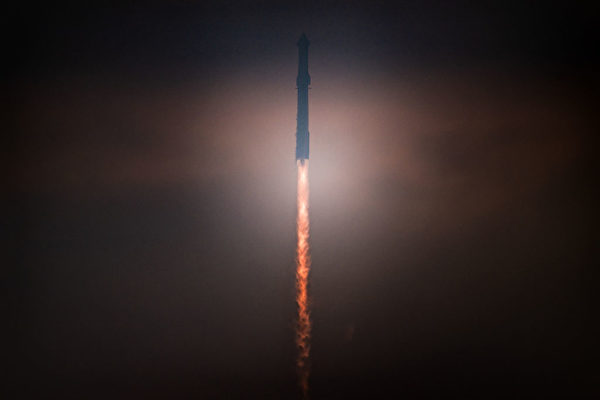On Thursday, June 6th, SpaceX’s Starship rocket completed a supersonic flight as it returned from space, achieving a groundbreaking landing demonstration in the Indian Ocean. This marked the fourth successful test mission of the rocket, setting multiple milestones and showcasing its reusability on a global scale. The National Aeronautics and Space Administration (NASA) stated that Thursday’s test further advances the goal of human return to the moon.
The Starship by SpaceX is the most powerful transport rocket ever built, and in Thursday’s launch, it met the key objective of its fourth test flight, demonstrating the reusability of this transport rocket.
Launched from Texas, the Starship successfully landed in the Indian Ocean 65 minutes later. This effort is part of the multi-billion-dollar investment made by SpaceX, owned by Elon Musk, in developing reusable satellite launchers and lunar landers.
Standing nearly 400 feet (120 meters) tall, the two-stage rocket system carrying the Starship was launched from the Starbase near the village of Boca Chica in southern Texas, with its powerful shockwaves reverberating through the morning mist along the Gulf of Mexico coast.
At 46 miles (74 kilometers) altitude, the Super Heavy booster separated from the Starship upper stage, with the Starship igniting its own engines to continue its journey into space. Simultaneously, the Super Heavy booster returned to the Gulf of Mexico and successfully soft-landed, showcasing a landing scene that was originally intended to take place on land.
In space, SpaceX’s live broadcast displayed the Starship, equipped with onboard cameras, gliding at a speed of 16,000 miles per hour (25,750 kilometers per hour) at an altitude of about 125 miles (200 kilometers). After orbiting half the Earth, the Starship successfully re-entered the atmosphere, splashing down in the Indian Ocean, demonstrating a key aspect of its reusability design.
The previous three test missions of the Starship ended in explosions or disintegration. In April 2023, the rocket’s first launch exploded minutes after ascending approximately 25 miles (40 kilometers) above the ground, while the second attempt in November exploded after entering space. The third test flight in March this year flew further but disintegrated at around 40 miles (64 kilometers) above the Indian Ocean during its descent into the atmosphere.
In Thursday’s test flight, the rocket achieved several milestones, including the survival of the Starship crew cabin in extreme high temperatures upon re-entry into the atmosphere, and successful splashdowns of both the crew cabin and the booster.
After separating from the spacecraft, the Super Heavy booster also successfully landed for the first time, gently touching down in the Gulf of Mexico approximately eight minutes post-launch.
Meanwhile, the Starship crew cabin successfully entered orbit. Around 50 minutes after launch, the spacecraft commenced controlled re-entry into the atmosphere. As the spacecraft’s heat shield faced the extreme temperatures of the Earth’s atmosphere, vibrant plasma accumulations in orange, red, blue-purple, and green hues marked the ship’s fiery descent through the atmosphere.
SpaceX’s Starlink satellites aided in maintaining continuous live feeds during re-entry. The shield near the camera’s field of view on the Starship appeared to burn during re-entry, obstructing part of the camera’s coverage.
As the Starship’s descent speed slowed due to intense atmospheric friction, metal fragments and hexagonal heat shield tiles began to fly off, with some portions of the rocket’s turning flaps stripping down to their skeletal structure but remaining functional.
In the descent phase, the Starship reignited its engines to flip itself upright, resembling a landing on the ground or the moon, before splashing down in the Indian Ocean. Musk, the CEO of SpaceX stated, “Despite losing many tiles and having a damaged flap, the Starship successfully landed softly in the ocean!” The successful re-entry of the Starship into the atmosphere was the primary goal of this mission, which Musk highlighted on social media following the splashdown.
Bill Nelson, the Administrator of NASA, also shared a post celebrating the successful test flight on Twitter. “Congratulations @SpaceX Starship on this morning’s successful test flight! We are one step closer to sending humans back to the moon through #Artemis and then looking ahead to Mars,” Nelson’s post read.
The rocket was covered with hundreds of black ceramic tiles designed to withstand extreme temperatures encountered during supersonic travel through the Earth’s atmosphere.
The design of the Starship is more cost-effective and powerful than SpaceX’s main Falcon 9 rocket, representing the future of the company’s dominance in satellite launch and astronaut missions. NASA plans to utilize it in the coming years to send astronauts to the moon.
NASA intends to use SpaceX’s Starship to send astronauts to the moon in 2026, competing with China’s plans to do the same before 2030.
SpaceX regularly assists NASA in transporting astronauts to and from the International Space Station using the crewed Dragon spacecraft, launched by SpaceX’s Falcon 9 rocket.
To date, no private company has successfully sent humans to the moon.

